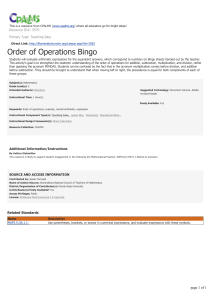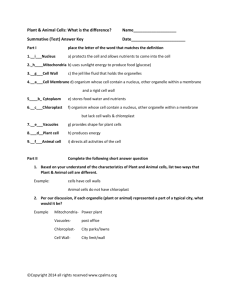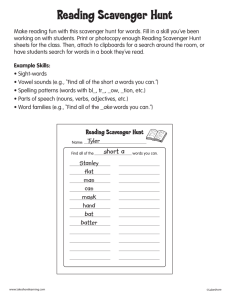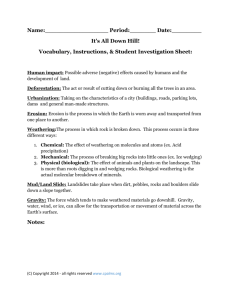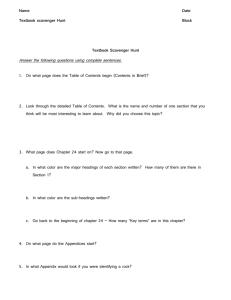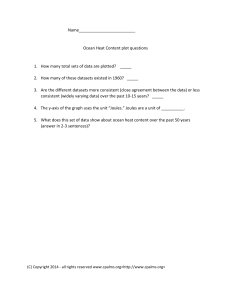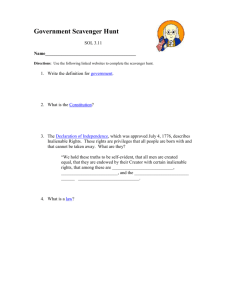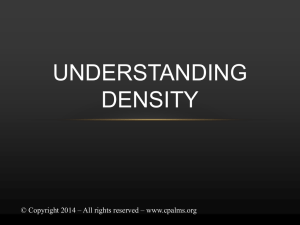District In-Service Grades 3-5
advertisement
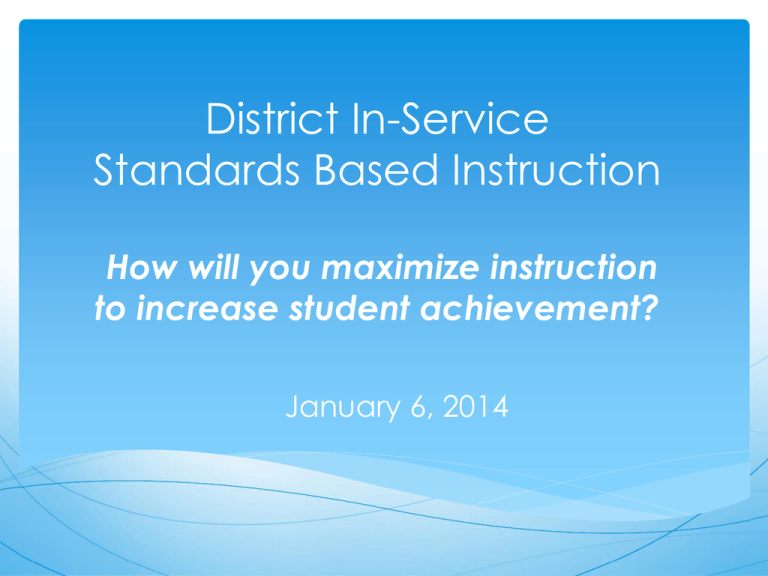
District In-Service Standards Based Instruction How will you maximize instruction to increase student achievement? January 6, 2014 Outcomes Review the essential components for unpacking the benchmarks by utilizing FCAT Test Item Specifications to reach the level of rigor expected of students by state standards. Synthesize the standards in an upcoming unit in order to develop a common definition of mastery for student learning for the end of the unit. Create a plan to maximize instructional time for quarter 3. Welcome Back! Today’s Learning Objective - unpacking standards to gain understanding and plan effectively Where do we begin? With unpacking ourselves! Find 5 things the entire group has in common (other than body parts, clothing, and occupation) First group finished wins! How to Access Assessment Maps http://www.manatee.k12.fl.us/curriculum/mcc /mcc.htm School District Home Page Departments Instructional Curriculum Link to Old Version of Site Identifying Middle School Standards Identify the standards for the next unit Translate broad goals to specific objectives Identify background knowledge Grade ELA Math Science Social Studies Grade 6 Unit 5 Unit 6 Unit 5 Unit 4 Grade 7 Unit 5 Unit 5 Unit 5 Unit 5 Grade 8 Unit 5 Unit 5 Unit 5 Unit 6 *Based on the Year at a Glance Calendar Identifying High School Standards Identify the standards for the next unit Translate broad goals to specific objectives Identify background knowledge Grade ELA Math Grade 9 English I, Unit 5 Algebra, Unit 5 Grade 10 English II, Unit 5 Geometry, Unit 5 Grade 11 *Based on the Year at a Glance Calendar Grade 12 Biology Social Studies Biology, Unit 5 U.S. History, Unit 8 Standards Matching Activity Matching standards and language of assessments can be challenging. 1. 2. 3. 4. Open envelope Separate questions and standards Match Review Standards Matching Answers: 6th Grade Standard Question(s) Answer(s) LA.6.2.1.2 5 B LA.6.1.7.3 3, 10, 11 B, C, D LA.6.6.1.1 13, 14 C, B Standards Matching Answers: 7th Grade Standard Question(s) Answer(s) LA.7.1.7.3 2, 3, 4, 9, 10 C, C, A, C, D LA.7.2.1.2 13, 14 C, A LA.7.1.7.7 5 B Standards Matching Answers: 8th Grade Standard Question(s) Answer(s) LA.8.2.1.2 8, 9, 10, 13, 15 B, C, B, C, D LA.8.1.6.3 1 D LA.8.1.7.3 6 B Standards Matching Answers: 9th Grade Standard Question(s) Answer(s) LA.910.6.1.1 4, 11, 15 A, D, C LA.910.1.6.3 7 A LA.910.1.7.3 2, 3 A, C Formative Assessments Select one standard your group used for the matching game. Log on to Quick Query and review district, school, and classroom data for this standard. Error Analysis Form Unwrapping – The Basics Learning Objectives – What do I want my students to understand? What skills and knowledge will they need? Evidence/Assessment- How do I know they understand? Planning- What next? Questions for Analyzing Standard Expectations What information should be generated during the analysis process? What do students need to Know? (Fact) What students need to Understand? (Concept) What students need to be able to Do? (Skill) Questions for Analyzing Standard Expectations What information should be generated during the analysis process? What prior knowledge do students need to have to be successful on this benchmark? What are possible misconceptions students may have with respect to this benchmark? Beginning the Unwrapping Process Consensus Protocol A team approach to determining unit goals Purpose: Collaborate in order to organize thoughts, make connections, and consolidate information to move teams toward shared expectations for student learning. Consensus Protocol Go to Cpalms website: http://www.cpalms.org/Public/ Click on Educator Toolkit for the appropriate grade Go to NGSSS Language Arts/ Reading to find your standard on your placement Consensus Protocol Standard: What are most important aspects of your standard? Individual responses on each side Group consensus in center Digging Deeper Analyzing Standards Assessment Calendar “Power Standards” CPalms: Test Specs Content Limits Content Focus Sample Test Items CPALMS SCAVENGER HUNT Scavenger Hunt Question #1 1. From home page, go to educator toolkit for seventh grade. 2. Then go to CCSS: English Language Arts Instructional Resources. 3. Click on “Uncoiling the Theme” and then the link next to “Resource Collection.” 4. How many published lessons are there in the CPalms Lesson Plan Development Initiative? Scavenger Hunt Question #2 1. From the CPalms home page, look under “Some of Our Resources” and click on “Model Eliciting Activities (MEAs). 2. What is the overarching goal of an MEA? Scavenger Hunt Question #3 1. Under “Standards” on the home page, click on “FCAT Specifications.” 2. Click on “Reading Specifications 2009” for Grades 6-8. 3. On what page of this document are text features discussed? ANSWERS 1. 1320 2. MEAs are interdisciplinary units that integrate STEM skills. 3. Page 6 How will you maximize instruction to increase student achievement? Student Performance: Data Science Student Performance: Culture Art High Quality Instruction or Instructional Delivery Instructional Delivery (Archer, 2011) Variety Modeling and demonstration by teachers and students Student exploration and collaboration Frequent assessment that produces valid data (formal and informal) Higher Order Questioning (Wilson, 2011) Asking follow-up questions Multiple Correct Responses(open-ended) Questions that require explanation and/or justification of thinking Rigor (Starr, 2010) Evidence of students working and thinking (verbal and written) Challenging students (comfortable discomfort?) Applying knowledge to new or familiar contexts Building new knowledge from existing knowledge Differentiated Instruction (Hall et al, 2003) Content addressed in multiple ways (same goals/different methods) Tasks related to identified individual needs (academic and behavioral data) Classroom Culture and Environment Classroom Management (Hall, 2002) Connection between classroom activities Strategies enhance interactions and student behavior Time management during and between tasks Classroom Environment (MSU, 2004) Configuration (where/how/why students are seated) Visuals and artifacts (meaningful resources) Safe learning (mistakes used as learning opportunities) Clean and orderly Student Engagement (Jones, 2008) Task, Questions, Responses, etc. (beyond compliant work) Interactions (Student to Student, Teacher to Student, Student to Teacher) Unit Planning Revisit your unit goals from the consensus placemat and identify which goals would occur at the beginning (B), middle (M), and end (E) of your unit. Use the two column planning tool to organize instructional strategies and resources for your next unit of study. Team Agenda Planning Planning for future units Complete the team agenda planning Exit Slip 5-3-1 Notecard – 1 per table (Use the same one on which you listed commonalities at the beginning of our morning.) Identify 5 key ideas shared today Discuss list with group Choose top 3 Highlight the most valuable idea presented today. Share. Resources Resource Web Address MCSB Intranet http://www.co.sbmc/ CPalms http://www.cpalms.org/Public/ Focus Florida Achieves http://focus.floridaachieves.com Problem Attic http://www.problemattic.com/ Blog with Today’s Handouts http://unpackingstandards.edu blogs.org/
